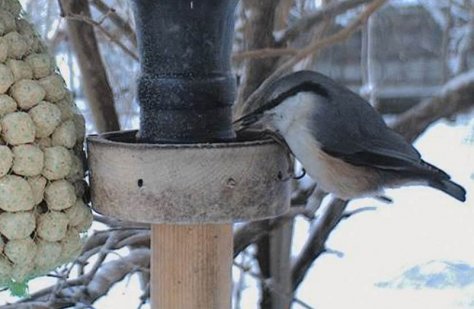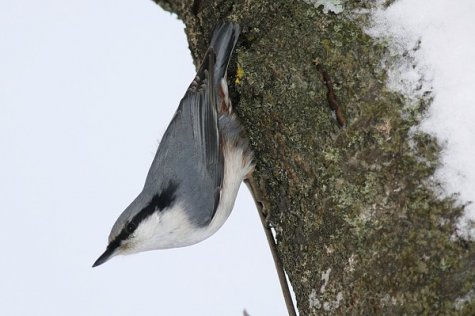Winter bird feeder webcam - Nuthatch
Web camera image recorded by Lispet, LK forum
Translation: Liis
Nuthatch Puukoristaja Sitta europaea
Nuthatches are extremely true to their nesting place, guarding their territory throughout the year, so we can see pairs busy together often enough near the feeding table.
The body of the streamlined nuthatch ends with a short strong tail. Crown and back plumage bluish grey, underparts whitish, white-tipped rust-coloured feathers covering the underside of the tail. Body length stays below 15 centimetres, weight a little over twenty grams. An eyecatching black eye stripe extends to the bird’s shoulder, beak dark grey, long and strong. Male and female have similar plumages.
Our only birds that can move on trees head downwards, without using support from leaning the tail against the tree trunk like woodpeckers or treecreepers. The brownish-yellow legs of the nuthatch are very short but the toes have a very large spread and long strong claws. On the ground they move in jumps. In the neighbourhood they move around with tit groups.
In the birdfeeder they pick up several sunflower seeds in the beak, to eat them in peace somewhere or hide them for storage in bark crevices. All kinds of seeds will do for nuthatches, but also lard. If you have a nice oat sheaf hanging somewhere it may turn out to be the preference of the nuthatches.
The nuthatch is a ”foolhardy” bird – not afraid of people nor cats, and other birds at the birdfeeder retreat when the ”boss” is in place; they know the home area and all its inhabitants well.
Who has time and a will can teach a nuthatch to eat out of the hand in the home garden.
In mainland Estonia nuthatches are common, in our islands rare. Winter abundance is estimated at up to a couple of hundred thousand birds together with those having arrived from the north, The winter garden bird count will show this year’s stand.
Nuthatch observations: LINK
Photo: Arne Ader
Nuthatch










